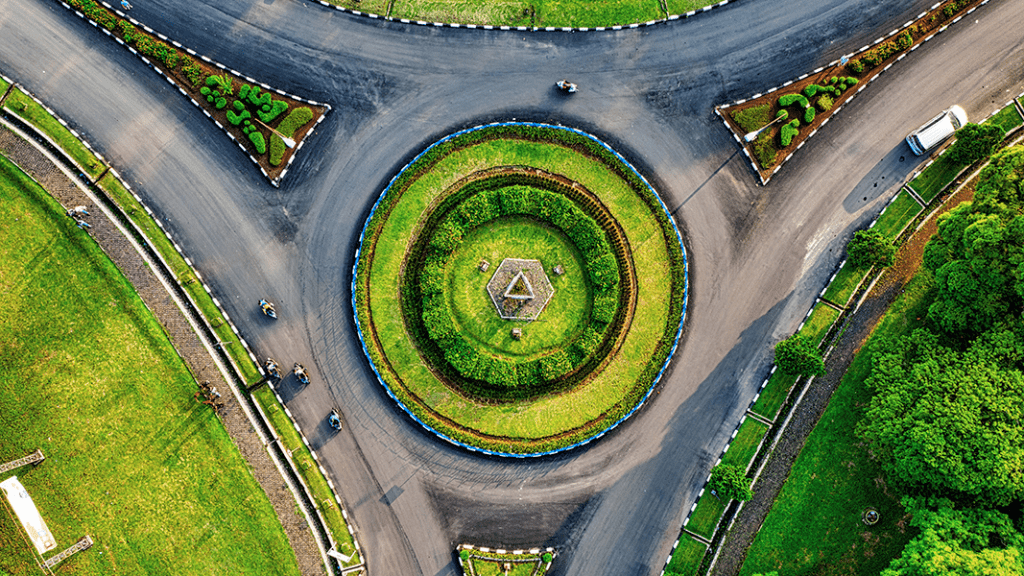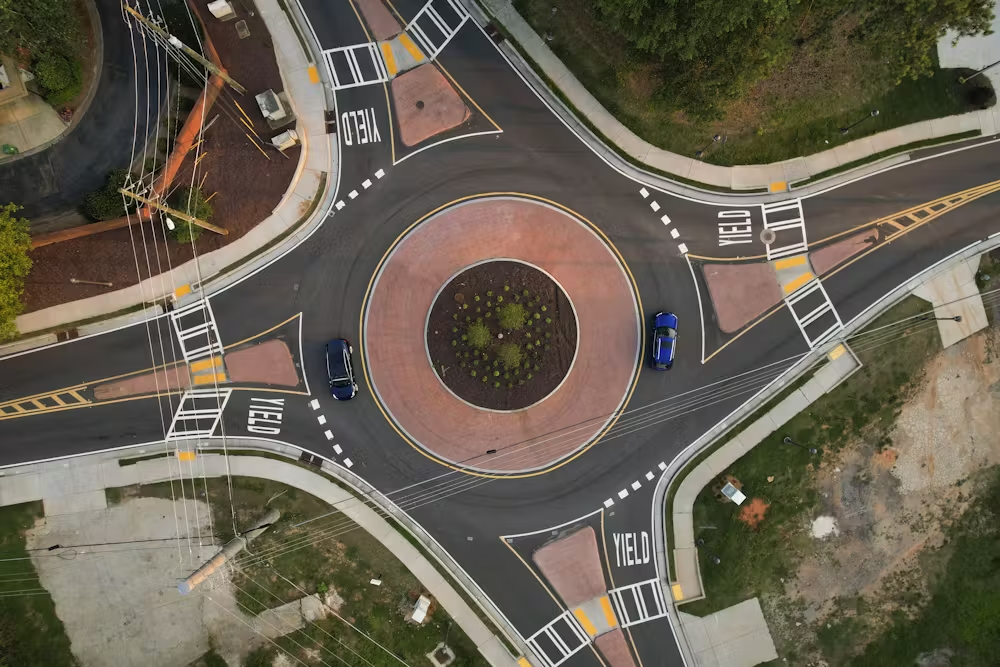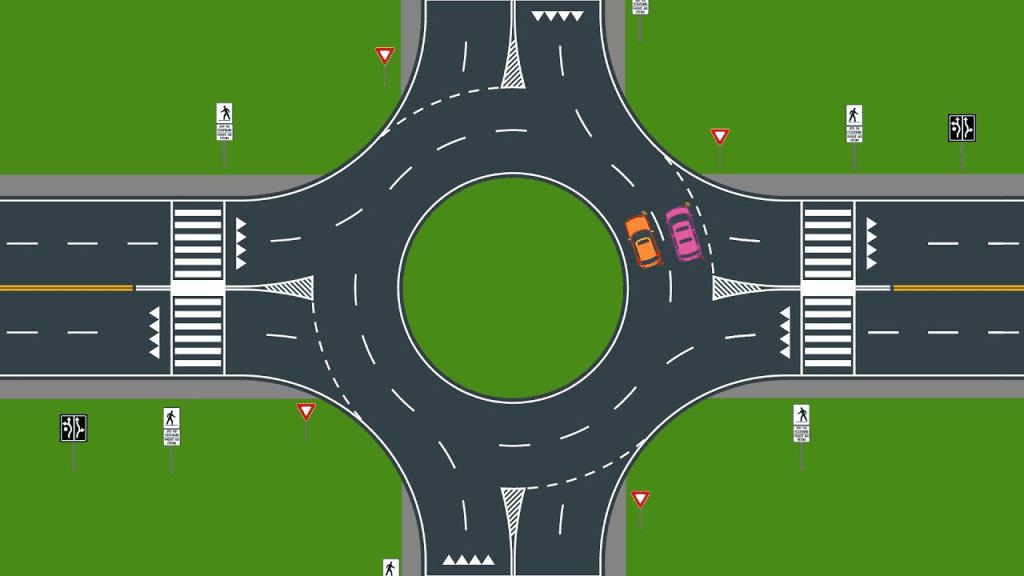If you’ve been driving through U.S. cities and towns, you’ve likely noticed an increase in roundabouts replacing traditional four-way intersections. Some drivers embrace them as an efficient traffic solution, while others find them confusing or even intimidating.
But what exactly is a roundabout, and why is it becoming a preferred alternative to stop signs and traffic signals? Roundabouts are not just about traffic flow—they are a safer, more efficient, and environmentally friendly way to design roads.
Let’s break down what roundabouts are, how they work, and why they are considered one of the most effective traffic management solutions today.
What is a Roundabout? Understanding the Basics

A roundabout—also known as a rotary or traffic circle—is a circular intersection where vehicles move counterclockwise around a central island. Unlike traditional intersections controlled by stop signs or traffic lights, roundabouts operate using a yield-at-entry system, meaning:
✔ Drivers entering the roundabout must yield to vehicles already circulating.
✔ Traffic flows continuously, reducing congestion and unnecessary stops.
✔ Speeds are naturally reduced, leading to safer driving conditions.
Most roundabouts also include:
🔹 Splitter islands – Raised medians that help slow down traffic before entering.
🔹 Pedestrian crosswalks – Positioned away from the central island to increase safety.
🔹 Lane markings – Clear indicators help guide drivers into the correct exit lane.
The result? A smoother, safer, and more efficient intersection that reduces both traffic delays and accidents.
A Brief History of Roundabouts
Many people assume roundabouts are a modern innovation, but their history dates back hundreds of years.
Video : Roundabout Safety Benefits
- 1700s – Early versions of circular intersections appeared in Europe, particularly in England and France.
- 1800s-1900s – Washington, D.C. was designed with multiple traffic circles, inspired by European models.
- 1950s – The United Kingdom introduced the yield-at-entry rule, transforming roundabouts into the efficient system we use today.
- 1990s – The first modern roundabout in the U.S. was built in Summerlin, Nevada in 1990.
- Today – Over 10,000 roundabouts exist in the United States, with more being installed every year.
While roundabouts have been common in Europe and Australia for decades, the U.S. is now rapidly adopting them due to their proven safety and efficiency benefits.
Why Roundabouts Are Safer Than Traditional Intersections
One of the biggest reasons cities are replacing traditional intersections with roundabouts is safety.
1. Fewer Conflict Points = Fewer Accidents
A typical four-way intersection has 32 conflict points—areas where vehicle paths cross, increasing the risk of collisions. In contrast, a roundabout reduces conflict points to just 8.
This means:
✔ No head-on collisions
✔ No dangerous T-bone crashes
✔ Fewer high-speed impacts
According to the Federal Highway Administration (FHWA), roundabouts can reduce serious and fatal crashes by up to 90% when replacing a stop-controlled intersection. Even when replacing a traffic signal intersection, they reduce serious crashes by nearly 80%.
2. Lower Speeds = Less Severe Collisions
In a roundabout, vehicles enter and exit at lower speeds (15-25 mph), compared to the higher speeds (40-50 mph) seen at traditional intersections.
Lower speeds lead to:
✔ Less severe crashes
✔ Fewer pedestrian injuries
✔ Easier decision-making for drivers
3. Safer for Pedestrians and Cyclists

Roundabouts offer better protection for pedestrians because:
✔ Crosswalks are set back from the circular flow, allowing drivers to see pedestrians clearly.
✔ Pedestrians only cross one direction of traffic at a time, making crossings safer.
✔ Cyclists can either merge into traffic or use a designated bike path, depending on the design.
With these safety features, roundabouts significantly reduce pedestrian-related accidents compared to traditional intersections.
Efficiency: Why Roundabouts Improve Traffic Flow
Beyond safety, roundabouts are also more efficient than stop signs or traffic lights.
1. Less Waiting, More Moving
At a traditional intersection, cars must stop at red lights, even when there’s no cross traffic. In a roundabout:
✔ Traffic keeps moving – No unnecessary stops.
✔ Fewer backups – No long wait times during rush hour.
✔ Reduced driver frustration – No more waiting for a green light when there’s no oncoming traffic.
2. Eliminating Left Turns = Smoother Flow
One of the most dangerous and disruptive movements at an intersection is the left turn. Roundabouts eliminate left turns, forcing all vehicles to move in the same direction, improving:
✔ Traffic efficiency – No waiting for gaps in oncoming traffic.
✔ Driver decision-making – No confusion about when to turn.
3. Roundabouts Handle High Traffic Volumes Better
Unlike stop signs and traffic lights, which cause congestion during peak hours, roundabouts allow continuous movement, making them ideal for high-traffic areas.
Environmental Benefits: How Roundabouts Help the Planet

Roundabouts aren’t just safer and more efficient—they also have environmental advantages.
1. Reduced Fuel Consumption
✔ Less idling at red lights = less wasted fuel
✔ Lower speeds = better fuel efficiency
According to studies, roundabouts can reduce fuel consumption by up to 30%, making them a cost-effective solution for drivers.
2. Lower Carbon Emissions
Fewer stops and starts mean lower emissions, helping reduce air pollution in urban areas. Cities that replace signalized intersections with roundabouts see:
✔ Less smog and pollution
✔ Improved air quality
3. Less Road Maintenance Required
✔ No traffic signals = lower maintenance costs
✔ Roundabouts last longer than traffic lights
With less infrastructure to maintain, roundabouts save cities money in the long run.
Challenges: Why Some Drivers Struggle with Roundabouts
Despite their many benefits, some drivers remain hesitant about roundabouts. Common challenges include:
🚦 Confusion about yielding – Some drivers don’t understand that they must yield to circulating traffic before entering.
🚦 Merging issues – Drivers unfamiliar with roundabouts sometimes hesitate, causing unnecessary slowdowns.
🚦 Exit mistakes – Some drivers find it difficult to choose the correct exit and miss their turn.
However, studies show that once drivers become familiar with roundabouts, their confidence improves significantly.
Video : Principles of Intersection Safety
Final Thoughts: Are Roundabouts the Future of Road Design?
Roundabouts are more than just a traffic trend—they are a safer, smarter, and greener solution for modern transportation. With their ability to reduce crashes, improve traffic flow, and lower emissions, they are quickly becoming a preferred alternative to traditional intersections.
🚗 Safer roads, fewer accidents
🚗 Smoother traffic, less congestion
🚗 Lower fuel costs, reduced pollution
As more states adopt roundabouts in urban and suburban planning, they will likely become a permanent feature of America’s roadways.
So next time you approach a roundabout, embrace the change—it’s making our roads safer and more efficient for everyone!
Demi Lovato Explains Why She Changed Her Pronouns From They/Them To She/Her

Summer is a great time to be outside and soak up the sun. However, it can be tough for our pets due to issues like fleas and ticks.
These small invaders can make you feel uncomfortable and spread illnesses, so it’s crucial to learn how to remove them safely and using natural methods.
We suggest: How can I get rid of plaque and bad breath in my dog?
There are many products available to get rid of fleas and ticks, but some can have strong chemicals that might hurt our pets’ health.
That’s why in this article, we share a simple, affordable, and easy-to-use recipe to help you naturally fight these bothersome parasites.

List of items needed to make a recipe.
- 200 milliliters of apple cider vinegar, which is equivalent to 6.7 ounces.
- A small amount of sea salt
- Half of a small spoon of baking soda
- Two or three tablespoons of lukewarm water.
Guidelines
- Mix apple cider vinegar, salt, and baking soda in a spray bottle.
- Pour the hot water into the mix and shake the bottle thoroughly to make sure all the ingredients are well combined.
- Apply the mixture on your pet’s fur, focusing on places like the ears, paws, and neck.
- You can use a comb to spread the mixture and get rid of any fleas and ticks on your pet’s fur.
- Before making this recipe, it is crucial to do an allergy test to make sure your pet won’t have any negative reactions to the ingredients.
Besides using this homemade recipe, it’s also crucial to regularly brush your pet to avoid flea and tick problems. By following these easy steps, you can keep your cat or dog free of parasites in a safe and natural way throughout the summer. Your pet will be grateful!



Leave a Reply